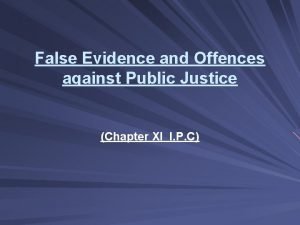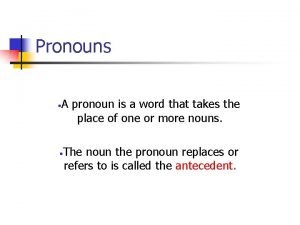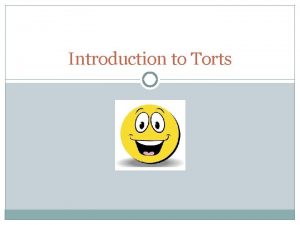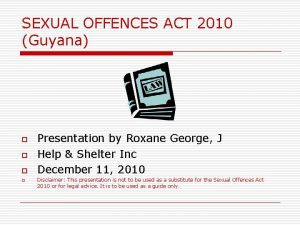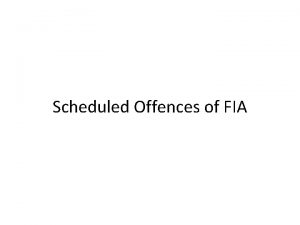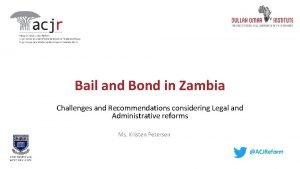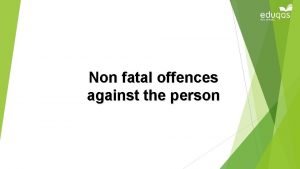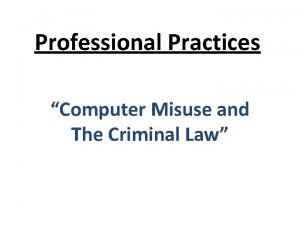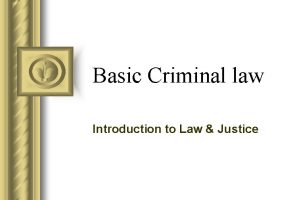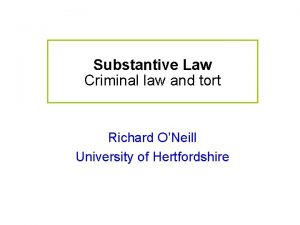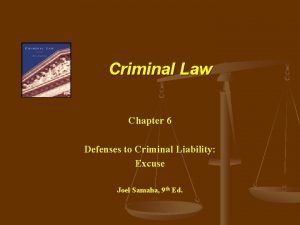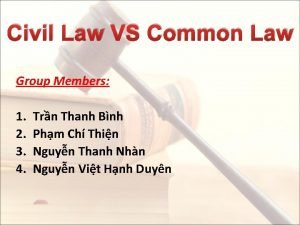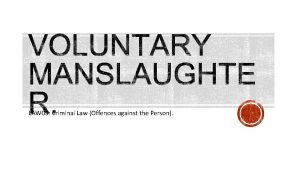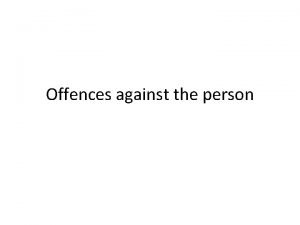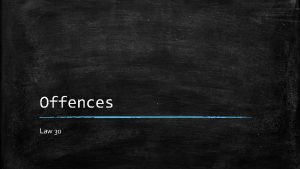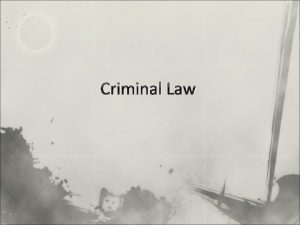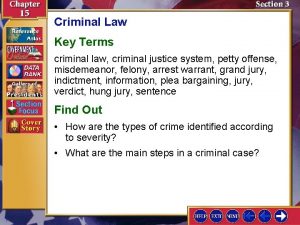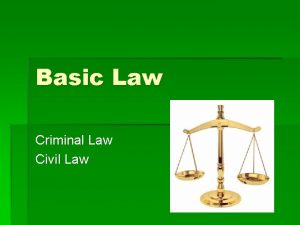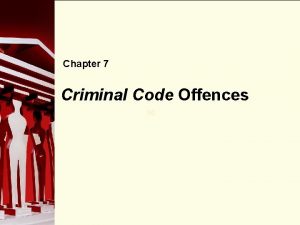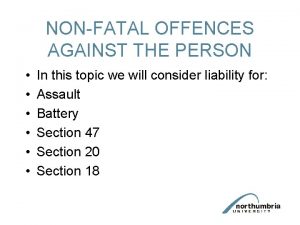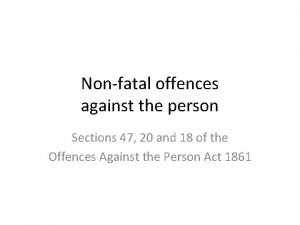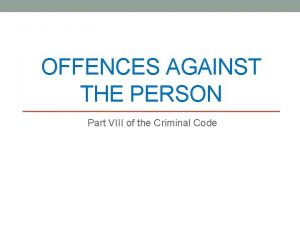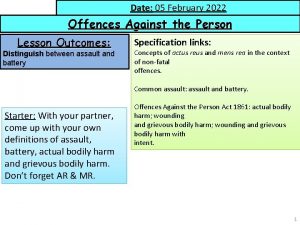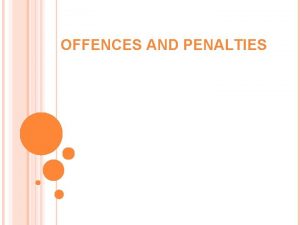LAW 03 Criminal Law Offences against the Person

























- Slides: 25

LAW 03: Criminal Law (Offences against the Person).


The defence of loss of control replaced the old defence of provocation and if it is successful the D will be found guilty of manslaughter and not murder. The defence is set out in s. 54 Coroners and Justice Act 2009.

"(1) Where a person kills or is party to the killing of another, D is not to be convicted of murder if – a) D's acts and omissions in doing or being party to the killing resulted from D's loss of self-control; b) The loss of self-control had a qualifying trigger, and; c) A person of D's sex and age, with a normal degree of tolerance and self restraint and in the circumstances of D, might have reacted in the same or in a similar way to D. "

It must be proved that the D had lost his self-control when doing the acts which caused the death. The loss of self-control does not need to be sudden. This means there could be a time delay between the qualifying trigger and the D's reaction in killing the V. This was not the case in the old defence of provocation.

As there no longer needs to be a sudden loss of control it is possible that Ds in situations like the one in Ahluwalia would be able to use the defence of loss of control. The D had been physically abused by her husband for years. One night, after he had threatened her with violence, D poured petrol over him and set him alight. He died 6 days later. D was convicted of murder and appealed. The appeal, based on provocation, failed because the D's reaction to his behaviour was not sudden.

The loss of self-control must be as a result of a qualifying trigger. s. 55 Coroners and Justice Act 2009 sets out the qualifying triggers.

s. 55(3): D fears serious violence from the V against himself or another identified person. s. 55(4): a thing or things done or said (or both) which – a) Constituted circumstances of an extremely grave character; and b) Caused D to have a justifiable sense of being seriously wronged. s. 55(5): the qualifying trigger can also be a combination of both these things.

The old law of provocation didn't allow a defence if the D lost control through a fear of violence, as shown in the case of Martin (Anthony) (2002). Battered wives, such as Ahluwalia, could also be able to use the defence if they are in fear of serious violence from their partners. The D does not have to just fear violence from the V. The fear could from another person as long as that other person is identified. A general fear of violence from a situation is not enough to satisfy the defence.

If the D is relying on things said or done as a qualifying trigger 2 criteria must also be met: 1. The things said or done must be of an extremely grave character; and 2. They must have caused the D to have a justifiable sense of being seriously wronged.

The introduction of these criteria make this defence much more restrictive than the old defence of provocation. Many situations that did qualify under the old defence would now not satisfy the defence of loss of control. For example, in Doughty, the D killed his 19 day old son because the child would not stop crying and he was allowed a defence of provocation because of 'things done'. Under the new defence it would be difficult for Doughty to prove that he had a 'justifiable sense of being seriously wronged' and the defence would fail.

This case confirmed that in order for things said and things done to be a qualifying trigger they must constitute circumstances of an extremely grave character and the D must have a justifiable sense of being seriously wronged. D's 94 year old father suffered from Alzheimer's disease and was also incontinent. D lost control and killed him after he repeatedly soiled himself. The D's defence of loss of control was not allowed.

The Act specifically states that sexual infidelity alone can never be a qualifying trigger for loss of control. The Government felt that the old law allowed a defence for jealous men that killed their wives and girlfriends because they were having an affair and that this was no longer acceptable. But, sexual infidelity can be considered if it is integral to and forms an essential part of the context where there are other factors which could be qualifying triggers.

Although sexual infidelity alone cannot satisfy a defence of loss of control the CA stated it could be taken into consideration when there were other factors that amounted to qualifying triggers. D suffered from depression and was on medication. The day before he killed his wife she told the D she was having an affair and had also taunted him about visiting suicide websites saying he didn't have the courage to kill himself. They argued and D killed her. D was convicted but his appeal was allowed.

The Coroners and Justice Act 2009 will also not allow a defence of loss of control if the D has acted in a considered desire for revenge. So, if the D has time to consider (plan) revenge the defence will not be available.

The gap of 5 days between the V's last 'provocative act' and the killing meant that the Ds had time to consider revenge against him. This was not a defence at the time and would certainly not be allowed as a defence under the defence of loss of control. The ex-boyfriend (V) of Ibrams' current girlfriend had been visiting their flat and terrorising them. On the 7 th October Ibrams called the police, who did nothing. On 10 th October the Ds made a plan to attack V and carried it out and killed V on 12 th October.

In the case of Baillie the D loses his control and acts with an element of a desire for revenge. His loss of control is sudden and technically his desire for revenge is not 'considered' as he has had no time to plan it. Under the Coroners and Justice Act 2009 it is unclear if this type of situation would satisfy the defence of loss of control as there is an element of revenge … but is it considered?

The Coroners and Justice Act 2009 requires that no matter which qualifying trigger is relied upon … " … a person of D's sex and age, with a normal degree of tolerance and self -restraint and in the circumstances of D, might have reacted in the same or similar way. " This is similar to the old law and the decision in the case of Camplin (1978).

In the judgement of the HL Lord Diplock stated: "The reasonable man is a person having the power of self-control to be expected of an ordinary person of the sex and age of the accused, but in other respects sharing such of the accused's characteristics as they think would affect the gravity of the provocation to him. " This was confirmed in the Privy Council case of AG for Jersey v Holley (2005).

The Coroners and Justice Act 2009 put this decision in Camplin into statutory form. So, the fact that the D is particularly hot-tempered is irrelevant when looking at the level of self-control expected. In short … when deciding if the reasonable man would also have lost their self-control only the sex and age of the D are relevant characteristics that can be transferred to the reasonable man.

However, when deciding if such a 'normal' person would have reacted in the same or similar way to the D ANY relevant characteristics of the D can be taken into consideration and transferred onto the reasonable man.

Under the Coroners and Justice Act 2009 the D's unemployment, depression and epilepsy would all be relevant characteristics that could be transferred to the reasonable man to determine whether he would have reacted in the same or similar way to the D. The D was unemployed and suffered from depression and epilepsy. The V taunted D about his unemployment, depression and epilepsy. D lost control and killed V. The evidence showed that the D was more sensitive to the taunts about his unemployment than anything else.

In this case the 'normal' person would have to have had a history of sexual abuse in deciding whether or not they would have reacted in the same or in a similar way to the D. The D had been sexually abused as a child. The V tried to sexually assault D and D lost control and killed V.

Voluntary intoxication is not a relevant characteristic when it comes to deciding if the reasonable man would have reacted in the same or similar way to the D (Asmelash (2013)).

Once the relevant characteristics have been identified the jury must consider whether a normal person in the circumstances of the D would have reacted as the D did. The defence will fail if the jury thinks the normal person would have lost control but would not have reacted in the same way. The case of Van Dongen (2005) is an example of this.
 Common offences against animals
Common offences against animals False evidence and offences against public justice
False evidence and offences against public justice Person singular plural
Person singular plural First second third point of view
First second third point of view Person person = new person()
Person person = new person() Example of personal pronoun
Example of personal pronoun Chapter 9 crimes against the person
Chapter 9 crimes against the person What is a civil law
What is a civil law Difference between civil law and criminal law
Difference between civil law and criminal law Guyana sexual offences act
Guyana sexual offences act Fia schedule offences
Fia schedule offences Pharmaceutical society of great britain v storkwain
Pharmaceutical society of great britain v storkwain Non bailable offences in zambia
Non bailable offences in zambia Strict liability in tort
Strict liability in tort سحاق
سحاق Evaluation of non fatal offences
Evaluation of non fatal offences Cybercrime offences inverness
Cybercrime offences inverness Non fatal offences evaluation
Non fatal offences evaluation Person against self
Person against self Computer misuse and criminal law pdf
Computer misuse and criminal law pdf Concurrence in criminal law
Concurrence in criminal law Taser 7 nomenclature
Taser 7 nomenclature Chapter 11 basic concepts street law
Chapter 11 basic concepts street law Tort richard
Tort richard M'naghten test elements
M'naghten test elements Difference between civil and criminal law table
Difference between civil and criminal law table

